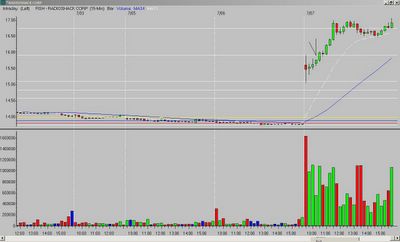
1.) What did I see?
A gap up and wide-range first bar. The second-fourth bars move up, and close in the upper half of the first bar's range. The fourth bar is an inside bar and the narrowest range of the morning (NRM).
2.) What is the entry?
A break of the fourth bar high*.
3.) What is the exit?
The target was the Fibonacci extension of the previous day's low to the opening range high; it was hit five bars later.
Set-up grade = B (the set-up was below the OR high)
*as with any entry below/above a previous high/low (in the case of my charts, the opening range (OR) high/low), you need to watch for resistance/support as price approaches those levels. If it stalls, you want to exit. If it breaks through, the odds are good you will have a move to the corresponding Fibonacci extension. In RSH, the fifth bar broke through and closed above the OR high.
__________
Tags:
Trader-X, Stocks, Fibonacci, Trading, RSH



3 comments:
X,
wasn't there an upcoming announcement at the end of June? Did I miss it?
Cheers
Babak - yes, I have been talking about a new "filter" that I have been testing. I have not been able to get the consistency I want to introduce it into the blog as part of my trading, but it is promising and I am sure many of you already use it. I said in June it was nothing special, and available to everyone.
It is (drumroll).....Pivot Points (that's it??? - yes). More specifically where price opens with respect to the PP, S1, S2, S3, R1, R2, R3. I just use the standard calculations that you can find in your software or on the net. I don't use the levels as Support/Resistance after the open (way too much stuff on the charts for not much of an added edge), rather I weed out candidates based on where price is in relation to them when the stock starts trading.
Play around, experiment. As I get more comfortable I will discuss it more. But that is it. What I have found is it raises my win rate a lot, but also severely limits the number of candidates. So, I am still working on a balance.
I use pivot points with my daily trading and actually use the delta R1-S1 to determine potential trades (e.g. higher volatility gets the nod). Have to be careful here - remembering that a low price stock won't move as much but you can usually buy more shares which sometimes makes up the difference.
Good trading all.
Post a Comment